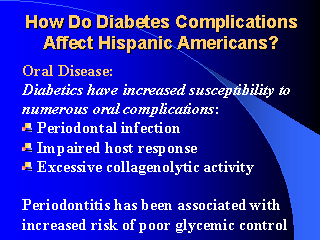|
|
|
|
front |1 |2 |3 |4 |5 |6 |7 |8 |9 |10 |11 |12 |13 |14 |15 |16 |17 |18 |19 |20 |21 |22 |23 |24 |25 |26 |27 |28 |29 |30 |31 |32 |33 |34 |review |
 |
Much data has been generated emphasizing the frequent occurrence of oral
infections in patients with Type 2 Diabetes Mellitus. Perhaps the most important
finding is that oral diseases are more severe and occur with higher frequency in
diabetic patients, especially if the diabetes is not well controlled. Oral
infections, particularly periodontitis, are commonly seen in patients with
diabetes. Periodontitis is a chronic inflammatory microbial infection of the
tissues that surrounds and supports the teeth. Diabetes and periodontitis are
two chronically linked conditions n which diabetes increases the risk of
developing destructive periodontal disease.
Destructive periodontal disease can result in loss of attachment of supporting ligaments and alveolar bone of the tooth and eventually, loss of involved teeth. Diabetes may complicate the pathogenesis of periodontitis by causing abnormalities in the vasculature of the gingival tissues, deregulating the normal production of cytokines and growth factors, decreasing the synthesis and cross-linking of collagen, increasing collagenase levels, and depressing immune responses. The reason for the greater occurrence of periodontal destruction in diabetes is not clear. However, studies of the periodontal flora find similar pathogens in diabetic and non-diabetic individuals, which could suggest, that the alteration in host defense-response to periodontal pathogens account for these differences in periodontal destruction. The risk of periodontitis among patients with poorly or uncontrolled diabetes is generally two to four times the risk among patients with properly controlled diabetes. A review of the literature suggests that tight metabolic control of blood glucose levels can block the onset of periodontal disease complications associated with diabetes. Furthermore, that prevention and control for oral infections must be part of the overall treatment plan for patients with diabetes mellitus. |